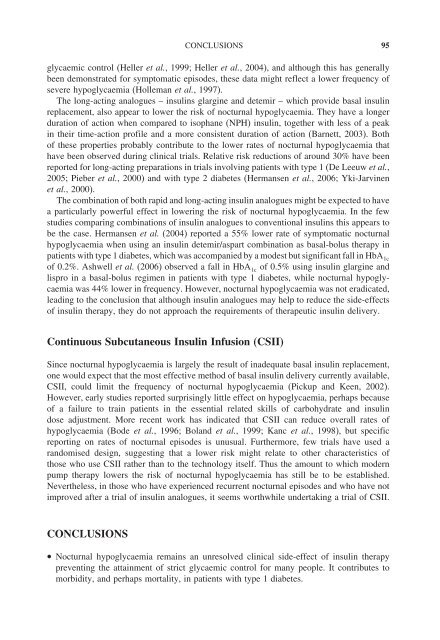Hypoglycaemia in Clinical Diabetes
Hypoglycaemia in Clinical Diabetes
Hypoglycaemia in Clinical Diabetes
- No tags were found...
You also want an ePaper? Increase the reach of your titles
YUMPU automatically turns print PDFs into web optimized ePapers that Google loves.
CONCLUSIONS 95glycaemic control (Heller et al., 1999; Heller et al., 2004), and although this has generallybeen demonstrated for symptomatic episodes, these data might reflect a lower frequency ofsevere hypoglycaemia (Holleman et al., 1997).The long-act<strong>in</strong>g analogues – <strong>in</strong>sul<strong>in</strong>s glarg<strong>in</strong>e and detemir – which provide basal <strong>in</strong>sul<strong>in</strong>replacement, also appear to lower the risk of nocturnal hypoglycaemia. They have a longerduration of action when compared to isophane (NPH) <strong>in</strong>sul<strong>in</strong>, together with less of a peak<strong>in</strong> their time-action profile and a more consistent duration of action (Barnett, 2003). Bothof these properties probably contribute to the lower rates of nocturnal hypoglycaemia thathave been observed dur<strong>in</strong>g cl<strong>in</strong>ical trials. Relative risk reductions of around 30% have beenreported for long-act<strong>in</strong>g preparations <strong>in</strong> trials <strong>in</strong>volv<strong>in</strong>g patients with type 1 (De Leeuw et al.,2005; Pieber et al., 2000) and with type 2 diabetes (Hermansen et al., 2006; Yki-Jarv<strong>in</strong>enet al., 2000).The comb<strong>in</strong>ation of both rapid and long-act<strong>in</strong>g <strong>in</strong>sul<strong>in</strong> analogues might be expected to havea particularly powerful effect <strong>in</strong> lower<strong>in</strong>g the risk of nocturnal hypoglycaemia. In the fewstudies compar<strong>in</strong>g comb<strong>in</strong>ations of <strong>in</strong>sul<strong>in</strong> analogues to conventional <strong>in</strong>sul<strong>in</strong>s this appears tobe the case. Hermansen et al. (2004) reported a 55% lower rate of symptomatic nocturnalhypoglycaemia when us<strong>in</strong>g an <strong>in</strong>sul<strong>in</strong> detemir/aspart comb<strong>in</strong>ation as basal-bolus therapy <strong>in</strong>patients with type 1 diabetes, which was accompanied by a modest but significant fall <strong>in</strong> HbA 1cof 0.2%. Ashwell et al. (2006) observed a fall <strong>in</strong> HbA 1c of 0.5% us<strong>in</strong>g <strong>in</strong>sul<strong>in</strong> glarg<strong>in</strong>e andlispro <strong>in</strong> a basal-bolus regimen <strong>in</strong> patients with type 1 diabetes, while nocturnal hypoglycaemiawas 44% lower <strong>in</strong> frequency. However, nocturnal hypoglycaemia was not eradicated,lead<strong>in</strong>g to the conclusion that although <strong>in</strong>sul<strong>in</strong> analogues may help to reduce the side-effectsof <strong>in</strong>sul<strong>in</strong> therapy, they do not approach the requirements of therapeutic <strong>in</strong>sul<strong>in</strong> delivery.Cont<strong>in</strong>uous Subcutaneous Insul<strong>in</strong> Infusion (CSII)S<strong>in</strong>ce nocturnal hypoglycaemia is largely the result of <strong>in</strong>adequate basal <strong>in</strong>sul<strong>in</strong> replacement,one would expect that the most effective method of basal <strong>in</strong>sul<strong>in</strong> delivery currently available,CSII, could limit the frequency of nocturnal hypoglycaemia (Pickup and Keen, 2002).However, early studies reported surpris<strong>in</strong>gly little effect on hypoglycaemia, perhaps becauseof a failure to tra<strong>in</strong> patients <strong>in</strong> the essential related skills of carbohydrate and <strong>in</strong>sul<strong>in</strong>dose adjustment. More recent work has <strong>in</strong>dicated that CSII can reduce overall rates ofhypoglycaemia (Bode et al., 1996; Boland et al., 1999; Kanc et al., 1998), but specificreport<strong>in</strong>g on rates of nocturnal episodes is unusual. Furthermore, few trials have used arandomised design, suggest<strong>in</strong>g that a lower risk might relate to other characteristics ofthose who use CSII rather than to the technology itself. Thus the amount to which modernpump therapy lowers the risk of nocturnal hypoglycaemia has still be to be established.Nevertheless, <strong>in</strong> those who have experienced recurrent nocturnal episodes and who have notimproved after a trial of <strong>in</strong>sul<strong>in</strong> analogues, it seems worthwhile undertak<strong>in</strong>g a trial of CSII.CONCLUSIONS• Nocturnal hypoglycaemia rema<strong>in</strong>s an unresolved cl<strong>in</strong>ical side-effect of <strong>in</strong>sul<strong>in</strong> therapyprevent<strong>in</strong>g the atta<strong>in</strong>ment of strict glycaemic control for many people. It contributes tomorbidity, and perhaps mortality, <strong>in</strong> patients with type 1 diabetes.
















